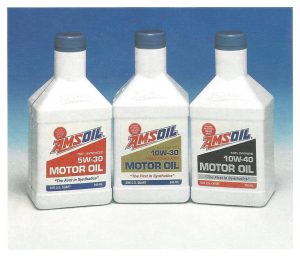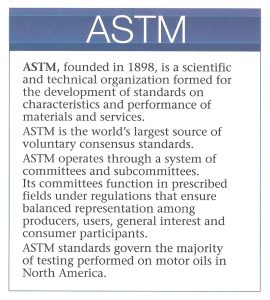
SLS Note: This is an older list (1997). Several of the tests have been updated and have new ASTM numbers as indicated by the ” / ASTM D xxxx”. This is not a complete list of the tests you will find on AMSOIL data bulletins and you won’t find all of these tests on every data bulletin. If you questions about any test on one of the AMSOIL data bulletin check with us for an answer.
KINEMATIC VISCOSITY
Test Number & Name: ASTM D-445 Standard Test Method for Kinematic Viscosity of Transparent and Opaque Liquids
Significance & Use: The proper operation of equipment depends on the proper kinematic viscosity at operating temperature of the oil used for its lubrication.
What it means: Kinematic viscosity is a measure of a liquid’s flow under the influence of gravity. It’s handy to think of a lubricant’s kinematic viscosity as its “I.D. card.” AMSOIL formulates its synthetic lubricants to tighter viscosity limits than other manufacturers do, so AMSOIL synthetic lubricants’ kinematic viscosities are midrange, close to neither the high or low limit. That helps components work their best and helps the lubricants stay in grade.
VISCOSITY INDEX
Test Number & Name: ASTM D-2270 Standard Practice for Calculating Viscosity Index from Kinematic Viscosity at 40° C and 100° C

Significance & Use: Viscosity index indicates how much a lubricant’s viscosity will change according to changes in temperature between 40°C (104°F) and 100°C (212° F), which roughly define the normal temperature range of most operations.
What it means: The smaller a lubricant’s viscosity change as a result of temperature change, the higher that lubricant’s viscosity index. High viscosity index lubricants, such as AMSOIL products, protect better in operations with temperature variations.
COLD CRANK SIMULATOR APPARENT VISCOSITY
Test Number & Name: ASTM D-5293 Standard Test Method for Apparent Viscosity of Engine Oils at Low Temperature Using the Cold-Cranking Simulator
Significance & Use: Apparent viscosity has been established as a valid predictor of engine-cranking viscosities at specified low temperatures. Apparent viscosity depends on temperature and shear rate.
What it means: Cold cranking viscosity affects the startability of engines and other equipment in cold temperatures. Low cold cranking viscosities, such as those of AMSOIL synthetic lubricants, make for easier cold cranking and more dependable cold temperature starting.
BORDERLINE PUMPING TEMPERATURE
Test Number & Name: ASTM D-4684 Standard Test Method for Predicting the Borderline Pumping Temperature of Engine Oil
Significance & Use: Borderline pumping temperature is a measure of the lowest temperature at which an engine oil can be continuously and adequately supplied to the components of an automotive engine.
What it means: The lower the borderline pumping temperature, the lower the temperature in which the engine is protected by circulating oil. AMSOIL synthetic motor oils’ extremely low borderline pumping temperatures assure excellent low temperature protection.
POUR POINT
Test Number & Name: ASTM D-97 Standard Test Method for Pour Point of Petroleum Oils
Significance & Use: The test determines the lowest temperature at which an oil flows as the jar is tilted for a prescribed period. The pour point of an oil indicates the lowest temperature at which an oil may be used in some applications.
What it means: The lower the pour point, the more useful the lubricant is in cold temperatures. AMSOIL synthetic lubricants offer exceptionally low pour points.
FLASH AND FIRE POINTS
Test Number & Name: ASTM D-92 Standard Test Method for Flash and Fire Points by Cleveland Open Cup
Significance & Use: Flash point is the lowest temperature at which application of a flame causes specimen vapors to ignite. Flash point is used to assess the overall hazard of a material and is used in shipping and safety regulations to define “flammable” and “combustible” materials.
Fire point is the lowest temperature at which a specimen sustains burning for five seconds.
What it means: Lubricants with high flash and fire points, such as AMSOIL synthetic lubricants, are safer to use and transport than lubricants with lower ones.
NOACK VOLATILITY
Test Number & Name: DIN 51581 / ASTM 5800 Determining the Evaporation Loss of Lubricating Oils (Noack’s Method)
Significance & Use: Test determines the evaporation loss of lubricating oils at high temperature. Evaporation loss is particularly important to motor and cylinder lubrication, due to the high temperature of these operations and the tendency of evaporative loss to increase in high temperatures. Significant evaporative loss of oil leads to excessive oil consumption and destructive changes in oil properties.
What it means: Lubricants with low Noack scores, such as AMSOIL synthetic lubricants, lose less to volatility than lubricants with higher scores. Low-loss oils keep their original protective and performance qualities longer than high-loss oils do, which keeps oil consumption low and fuel economy and equipment protection high.
HIGH TEMPERATURE/HIGH SHEAR VISCOSITY
Test Number & Name: ASTM D-4683 / D 5481 Standard Test Method for Measuring Viscosity at High Temperature and High Shear Rate by Tapered Bearing Simulator
Significance & Use: Viscosity at the shear rate and temperature of this test is considered representative of the condition encountered in the bearings of automotive engines in severe service. Lubricant viscosity in the bearings of automotive engines in severe service is a critical factor in bearing wear.
What it means: Lubricants with high scores, such as AMSOIL synthetic lubricants, maintain their viscosity in high temperatures after exposure to high shear. That means they continue to protect engine bearings even after exposure to severe service conditions.
FOUR BALL WEAR TEST

Test Number and Name: ASTM D-4172 Standard Test Method for Wear Preventive Characteristics of Lubricating Fluid (Four-Ball Method)
Significance & Use: Test method determines the relative wear preventive properties of lubricants in sliding contact under the test conditions. Lubricant comparisons are made by comparing the average wear scars on three fixed balls made by one ball in rotating contact with them in baths of the test lubricants.
What it means: The smaller the average wear scar, the better the protection. AMSOIL synthetic lubricants deliver much smaller wear scars – and much better protection – than other lubricants do.
The Four Ball Wear Test may be conducted at various levels of severity. Independent laboratory testing shows that AMSOIL Series 2000 and Series 3000 motor oils’ wear scars are significantly smaller than those of popular competitor oils in extremely severe test conditions, making these oils ideal for extreme service engine operations.

For Data Bulletins On Any AMSOIL Product Select The Product, Select “Technical Specifications” and scroll down the available options.
*All trademarked names and images are the property of their respective owners and may be registered marks in some countries. No affiliation or endorsement claim, express or implied, is made by their use. All products advertised here are developed by AMSOIL for the use in the application shown.
Reproduced With The Permission Of AMSOIL INC. All Rights Reserved.
For more information or pricing on the quality line of AMSOIL Products contact SLS Associates. Whether you are a Consumer, Retailer, or Commercial Business, we will answer your questions, explain any options and you take it from there. If you choose to try AMSOIL products we will give you our best price and you make the decision. No pressure. It’s your choice.
Click Here if you would like to browse the current AMSOIL Catalog
